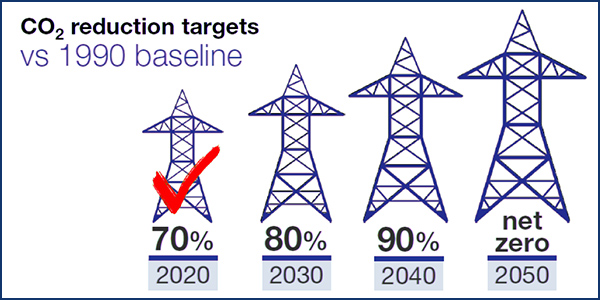Representatives of three of the dominant utilities in New England on Wednesday briefed Northeast Energy and Commerce Association members about their companies’ aggressive decarbonization efforts, suggesting that many other utilities will need to step up their games to reach net-zero emissions by 2050 — the year by which climate experts say the world must stop emitting carbon entirely or find some way to remove it from the atmosphere to prevent catastrophic environmental changes.
Officials from Avangrid, National Grid and Eversource Energy spent most of their presentations triumphantly pointing to the progress they have made toward their decarbonization goals. The strategies laid out by the officials ran the familiar gamut: aggressive investment in renewable resources, upgrading the transmission system to make it more efficient and co-locating new renewables with storage.
Driven by legislation passed by states in their service territories, the utilities are indeed well on their way to reaching their targets — for now. National Grid last year, for example, upped its goal from an 80% reduction by 2050 from 1990 levels to net-zero emissions by then. Its also increased its interim goals, having already achieved its previously 70%-by-2030 target this year; it’s now targeting 80% by 2030.
Avangrid’s generation mix is made up almost entirely of wind energy, with 7.4 GW of onshore resources in operation, and another 9.6 GW in development, both on- and offshore. It expects to be carbon-neutral by the end of 2035 — the year its last remaining fossil fuel plant, the Klamath Cogeneration Project in Oregon, will reach the end of its useful life.
But the speakers cautioned that these strategies will get utilities only so far in reaching net-zero emissions by 2050. Nascent technology such as long-duration energy storage, carbon capture and sequestration, and renewable natural gas will be needed not just to offset emissions but to balance the intermittency of renewable resources, they said.
“High penetrations of renewables are going to need some truly flexible power plants to balance them … which means, for many utilities, natural gas,” said Javier Ceña, Avangrid’s executive director of sustainability. “So the electric sector might need to rely on carbon capture or carbon-free fuels, like green natural gas or green hydrogen, to reach carbon neutrality by 2050.”
He pointed to Avangrid parent company Iberdrola’s demonstration project in Puertollano, Spain, that will use a combination of solar and electric storage to produce hydrogen.
National Grid is also in the early stages of developing a program to counter emissions. “As much as our primary focus is to reduce our emissions, we do believe that we will have to do some offsetting in 2050,” said Michele Leone, director of sustainability and environment. “So right now we’re looking to develop a program … looking at local partnerships, looking at co-benefits of various offsetting options.”
Eversource has perhaps one of the most aggressive targets in the U.S.: carbon neutrality by 2030. Its strategy is to first reduce its own greenhouse gas emissions “to the maximum extent possible,” according to Catherine Finneran, vice president of sustainability and environmental affairs. “And then … we’ll offset those emissions, whether through the purchase of offsets or the development of initiatives that produce the offsets.”
Both National Grid and Eversource said they’re also focusing on reducing leakages of methane from their natural gas pipelines and of sulfur hexafluoride (SF6) — an extremely potent greenhouse gas rarely mentioned compared to carbon dioxide and methane — which is used in switchgear as an insulator.
SF6 “might look like a small amount of our footprint, but it is a very big focus for us,” Finneran said. The company is working with its suppliers to phase in SF6-free equipment over the next five years. The challenge, however, is that such equipment is only available for lower-voltage equipment, “and we really need it also at higher voltages as well,” she said.






